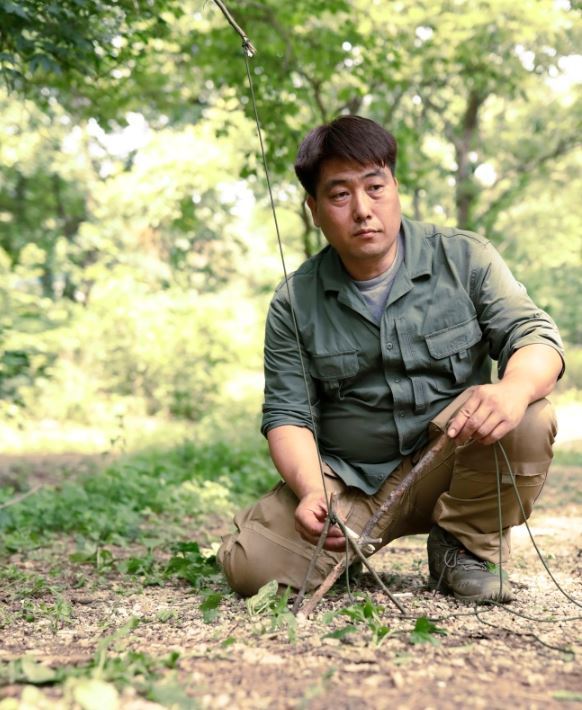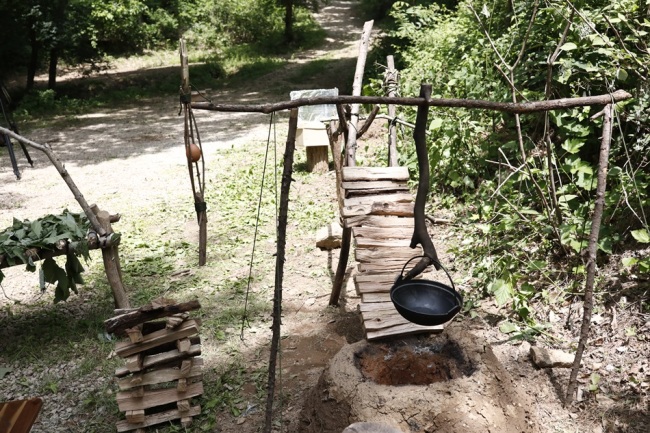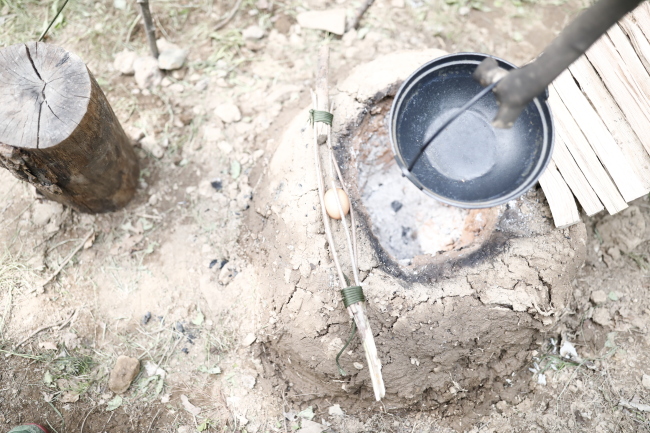The camping season is here and many are packing their bags with tents and fancy gear to enjoy outdoor barbecues. But Han Ho-jun, a 45-year veteran of camping, says the true charm of the outdoor life lies in bush craft.
“You can truly feel the freedom of thriving in the wild, and obtain a sense of accomplishment by building your own shelter and tools with the materials you find in nature,” Han, 45, told The Korea Herald.

(Han Ho-jun)
Bush craft is a term referring to wilderness survival skills, and in the context of camping this usually includes fishing, tracking, navigating by natural means and foraging.
“Everyone has a hobby. Those in my age can go golfing, or fishing to relieve stress, and for me, it’s camping in the wild,” Han said.
His history with outdoor camping dates back to 1992, when he served for South Korea’s Special Forces for four years and mastered survival techniques.
“The experiences and training I got at the time has helped me a lot for my bush craft hobby, and familiarity with the nature,” Han said.
After he was discharged from the military, he started working for a big construction company in 1997. After an exhausting day of work, he would go drinking with his colleagues and the days would repeat. He wanted something to refresh himself.
His love for the wild led him to develop outdoor camping and bush craft as a weekend pursuit. With nearly 25-years of experience, Han also started a camping business, Hans Camping, in 2015 to come up with equipment that minimizes shortcomings at camping sites. He quit his work at the construction company last year.
Nowadays, auto camping is a weekly event for Han, and he practices bush craft at least once a month.

(Han Ho-jun)
The mission of the day is focused making the day’s living in the forest, alone. As unlicensed hunting is prohibited in Korea, he mainly eats fish, which he catches in nearby streams.
Last week in Mungwoo-ri Ravine Camping site in Pocheon, Gyeonggi Province, he caught a catfish with a fishing device he fashioned from tree branches.
“There, I was lucky to catch a catfish. Usually we find carp and snakeheads there,” Han said. “One of the most easily found food sources from water is crawfish. If you fry it completely with sesame oil, it tastes great and will kill all distomas.”
Plants and medicinal herbs such as acanthopanax and Korean angelica roots are also easy to obtain, and at times he brings a raw chicken to boil with the herbs to cook a Korean traditional dish -- baeksuk.
Kudzu roots are the best source for hydration and hunger if one fails to catch the day’s meal and salamander eggs and grubs are also a good source of protein.
One of the charming points about bush craft is that you do not have to take a lot of gear with you. While he is operating a camping gear business himself, Han still feels that they can become the burden dragging you down from enjoying nature at its fullest.
“One of the reasons I bush craft is to get away from all the manufactured, framed modern life,” Han said. “I also feel a great sense of achievement and joy when I make my own furniture, and try out different ways to make things work.”
Han makes his own tent by hanging a parachute on a tree branch, and he will make fire using a battery and chewing gum foil. From a fishing rod to a microwave and a table, Han uses the materials he can find in his surroundings, without the help of electricity.
But it is also crucial that campers bring a first aid kit and substitutes for plan B in case more primitive options fail.
“You have to bring basic stuff -- a pocket knife, a whistle, flint or a lighter and a flash light -- even if you do not want to use the artificial light. And canned food or ramen for plan B, because you are going there for fun, not for a life threatening experience,” Han said.
As for beginners, it is very important that they go with someone who is experienced in bushcraft, and the last thing one should do is to go alone after watching a couple of YouTube videos, Han said.
“Many of the video clips are shot in other countries and the situation may be very different from here. Besides, the clips are very limited, and the reality can turn out to be very different on every occasion,” he said.

(Han Ho-jun)
The very first thing a camper should do when they arrive at the camping site is to look around the areas to get a grasp of the geographical features to find the right spot to set up a headquarters. Han explained that overlooking this can become the major cause of an accident, especially at night when campers have to depend on a flashlight.
A rule No. 1 for the campers to bear in mind is to not damage the forest and come back without leaving a trace.
“For lighting a bonfire, always bring a large steel plate to put below the ground to avoid burning microoganisms. I also use dead branches for the fire, and wooden planks, instead of cutting live trees.”
Encountering wild animals is also part of outdoor camping, and Han warned that one should always remain calm to avoid any dangerous situations.
“On camping sites, snakes and wasps are frequent visitors, but you have to remember that it is humans that invaded their habitats. If you panic and take threatening action, they will attack you. Be part of the environment, and they will just pass you by,” Han said.
By Jo He-rim (
herim@heraldcorp.com)








